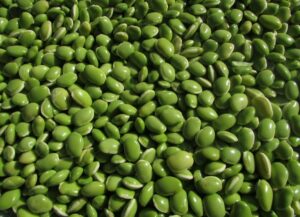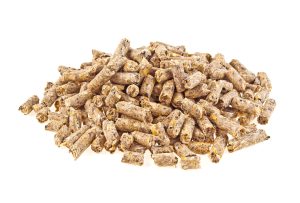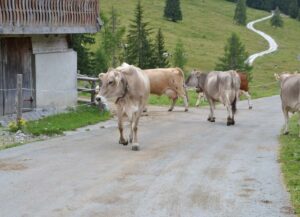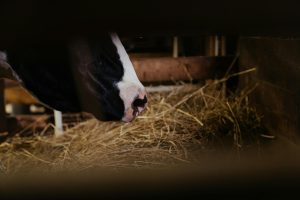Alvaro Garcia
The key to adequate dairy cow feeding is the inclusion of feedstuffs in the diet that complement each other. Protein and energy are the most expensive macronutrients, and optimizing their metabolism is very important to improve income over feed costs. Field pea (Pisum sativum) is a crop used in the human food chain, commonly grown in the US northern great plains and Canada.. Their relatively high crude protein (avg. 21.0%) and starch (avg. 44.9%) concentrations makes them then an attractive ingredient in cattle diets. Most of their protein however is soluble protein which needs to be adequately balanced to sustain acceptable dry matter (DM) intake, milk yield, and N utilization by lactating dairy cows.
Negative responses in milk and milk true protein yields have been observed at higher dietary inclusions (i.e., 24-36% of diet DM). These negative effects however have not been apparent when rumen-protected methionine (Methionine) and lysine were added to diets with more than 25% ground field peas (peas). Earlier results also suggest that when peas constituted 25% of the diet DM, methionine was first limiting AA, with histidine, leucine, and phenylalanine also at less than adequate concentrations.
A recent study (Pereira et al., 2020) evaluated the effects on production, nutrient digestibility, and N metabolism of cows fed 25% peas of diets that contained soybean meal (SBM) or canola meal (CM) and with or without addition of Methionine. Cows were fed (DM basis) 35% corn silage, 14% grass-legume haylage, 25% peas, and 11% SBM or 13.5% CM with or without Methionine supplementation on a 49:51 forage-to-concentrate ratio. The peas tested 19.8% protein, 75% soluble protein (% CP), and 49.5% starch.
Treatments (DM basis):
- 11% SBM and 25% peas (SB diet)
- 11% SBM, 25% peas, and 0.095% Methionine (SBM + Methionine diet)
- 5% CM and 25% peas (CM diet)
- 5% CM, 25% peas, and 0.095% Methionine (CM + Methionine diet)
Cows fed CM and CM + Methionine had a 3.2% increase in DMI compared with those offered SBM and SBM + Methionine. Feed efficiencies were unaffected by protein source, and neither were concentrations of milk fat and true protein. Milk lactose and SNF concentrations increased, whereas milk total solids tended to increase in cows fed SBM and SBM + Methionine compared to CM and CM + Methionine diets.
Yields of milk fat, true protein, solids non-fat, and total solids followed milk yield were all greater with CM and CM + Methionine versus SBM and SBM + Methionine diets. Cows fed CM and CM + Methionine had lower milk urea nitrogen (MUN) concentration than those on SBM and SBM + Methionine. These results suggest that protein from CM was less degradable in the rumen than that from SBM. As expected, the plasma urea nitrogen (PUN) followed MUN concentrations and decreased with CM and CM + Methionine compared to SBM and SBM + Methionine. The fact that MUN and PUN were lower, and milk true protein yield higher in cows on CM, indicated improved efficiency of N utilization in the body. In addition, individual EAA in blood increased in cows fed CM and CM + Methionine when compared to SBM and SBM + Methionine.
In summary, protein source affected most production variables. Cows fed CM plus peas had greater DMI, yields of milk and milk fat and true protein, and milk N efficiency than those offered SBM plus peas. Feeding CM plus peas also reduced the concentrations of milk urea N and plasma urea N, and the urinary excretion of NH3-N and urea N, suggesting improved N use efficiency.
Moreover, replacing SBM with CM increased concentrations of all essential AA (except Arg) in plasma. Lysine was overall the first limiting AA in blood, while Met was first limiting in diets without Methionine. Plasma methionine concentrations increased 63% with Methionine supplementation. Total-tract digestibility of DM, organic matter, N, and ADF increased with feeding SBM plus peas compared to CM plus peas. Judging by the improved yields of milk and milk protein and N use efficiency CM appears to be a better companion to peas as a rumen-degradable protein source than SBM when the former is at high concentrations (25% of the diet DM).
Reference:
Pereira, A.B.D., Moura, D.C., Whitehouse, N.L., Brito, A.F. 2020. Production and nitrogen metabolism in lactating dairy cows fed finely ground field pea plus soybean meal or canola meal with or without rumen-protected methionine supplementation. Journal of Dairy Science. 103(4): 3161-3176.
© 2020 Dairy Knowledge Center. All Rights Reserved.









